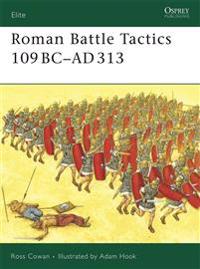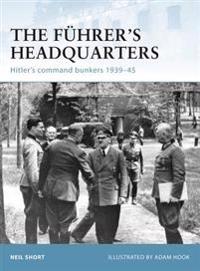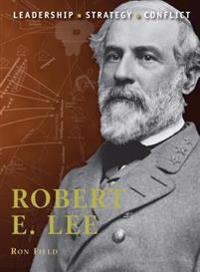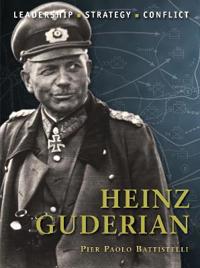Pharsalus 48 Bc (Pocket)
avSi Sheppard, Adam Hook, Si Sheppard
ISBN: 9781846030024 - UTGIVEN: 200609In 48 BC, the stage was set for the final clash of the two titans of the Roman world and the odds were heavily in Pompey's favour, with 45,000 men against Caesar's 22,000. Having the dice loaded against him, however, seems to have stimulated Caesar's guile and genius for battle: guessing that Pompey[...]
World War I Gas Warfare Tactics and Equipment (Pocket)
avSimon Jones, Richard (ILT) Hook, Simon Jones
ISBN: 9781846031519 - UTGIVEN: 2007-01Battlefield Gas was first employed in April 1915 at the village of Langemarck near Ypres. At 1700 hours, the Germans released a five mile-wide cloud of 168 tons of chlorine gas from 520 cylinders, causing panic and death in the French and Algerian trenches. Despite initial widespread condemnation an[...]
Roman Battle Tactics 109BC-AD313 (Pocket)
avRoss Cowan, Adam Hook, Ross Cowan
ISBN: 9781846031847 - UTGIVEN: 200707The book clearly explains and illustrates the mechanics of how Roman commanders - at every level - drew up and committed their different types of troops for open-field battles. It includes the alternative formations used to handle different tactical problems and different types of terrain; the possi[...]
London 1914-17 (Pocket)
avIan Castle, Christa (ILT) Hook, Ian Castle
ISBN: 9781846032455 - UTGIVEN: 2008-03The first Zeppelin attack on London came in May 1915 - and with it came the birth of a new arena of warfare, the 'home front'. German airships attempted to raid London on 26 separate occasions between May 1915 and October 1917, but only reached the capital and bombed successfully on nine occasions, [...]
Frontier Militiaman in the War of 1812 (Pocket)
avEd Gilbert, Adam Hook, Ed Gilbert
ISBN: 9781846032752 - UTGIVEN: 200809"He who relies on militia leans upon a broken cane." (George Washington)
Osprey's survey of militiamen of the War of 1812. The great military effectiveness of semi-trained local militia is one of the enduring myths of American military history. In this book Ed Gilbert reveals the truth b[...]Special Operations Forces in Iraq (Pocket)
avLeigh Neville, Richard (ILT) Hook, Leigh Neville
ISBN: 9781846033575 - UTGIVEN: 2008-11In this companion volume to "Elite 163: Special Operations Forces in Afghanistan", Leigh Neville now turns his expert analysis to the Special Operations Forces (SOF) of the US and Coalition allies serving in Iraq since 2003. Filled with recently declassified material, first hand accounts, and unique[...]
Maori Fortifications (Pocket)
avIan Knight, Adam (ILT) Hook, Ian Knight
ISBN: 9781846033704 - UTGIVEN: 2009-04The Maori people of New Zealand were experienced field engineers and it was common practice to protect villages with surrounding entrenchments and wooden palisades, known as pas. However, it was not until 1845, with the first fighting between the Maori and the British, that it became clear just how [...]
The Atlantic Wall (2) (Pocket)
avSteven J. Zaloga, Adam (ILT) Hook, Steven J. Zaloga
ISBN: 9781846033933 - UTGIVEN: 2009-11Germany's Atlantic Wall was the most ambitious military fortification program of World War II. Following its conquest of Western Europe, Germany had to defend some 5,000km of Atlantic coastline from the Spanish border to the Arctic Circle. The United States' entry into the war and the inevitability [...]
The Mongol Invasions of Japan 1274 and 1281 (Pocket)
avStephen R. Turnbull, Richard (ILT) Hook, Stephen R. Turnbull
ISBN: 9781846034565 - UTGIVEN: 2010-01From his seat in Xanadu, the great Mongol Emperor of China, Kubla Khan, had long plotted an invasion of Japan. However, it was only with the acquisition of Korea, that the Khan gained the maritime resources necessary for such a major amphibious operation. Written by eastern warfare expert Stephen Tu[...]
The Seminole Wars 1818-58 (Pocket)
avRon Field, Richard (ILT) Hook, Ron Field
ISBN: 9781846034619 - UTGIVEN: 2009-08The Seminole of Florida were one of five so-called 'Civilized Tribes' who for many years lived in peace with the settlers. However, by 1815, frontier Americans had grown increasingly envious of their relative wealth and land, and resentful of their harbouring of former slaves. This book reveals the [...]
Office of Strategic Services 1942-45 (Pocket)
avEugene Liptak, Richard Hook, Eugene Liptak
ISBN: 9781846034633 - UTGIVEN: 200908The Office of Strategic Services, the forerunner of the CIA, was founded in 1942 by William 'Wild Bill' Donovan under the direction of President Roosevelt. Agents were enlisted from both the armed services and civilians to produce operational groups specialising in different foreign areas including [...]
Pike and Shot Tactics 1590-1660 (Pocket)
avKeith Roberts, Adam Hook, Keith Roberts
ISBN: 9781846034695 - UTGIVEN: 201003Throughout the 17th century large parts of Europe were depopulated during the wide-ranging and savage wars of religion and dynasty, involving all of the major powers. This was therefore a key period in the development of 'modern' infantry tactics, such as the use of pole-arms and muskets together - [...]
Hatamoto (Pocket)
avStephen Turnbull, Richard (ILT) Hook, Stephen Turnbull
ISBN: 9781846034787 - UTGIVEN: 2010-03Each great samurai warlord, or daimyo, had a division of troops known as the Hatamoto, 'those who stand under the flag'. The Hatamoto included the personal bodyguards, the senior generals, the standard bearers and colour-guard, the couriers, and the other samurai under the warlord's personal command[...]
Prussian Napoleonic Tactics 1792-1815 (Pocket)
avPeter Hofschroer, Adam (ILT) Hook, Martin (EDT) Windrow
ISBN: 9781846035098 - UTGIVEN: 2011-10"Prussian Napoleonic Tactics: 1792-1815".
The Fuhrer's Headquarters (Pocket)
avNeil Short, Adam Hook, Neil Short
ISBN: 9781846035821 - UTGIVEN: 201010The 100th title in "The Fortress Series", this book describes and examines the Fuhrerhauptquartiere - the 14 or so headquarters built for Hitler. Revealing their locations and how they were used to direct the Nazi war apparatus, this is a fascinating insight into a range of historical sites from Ber[...]
Breakfast at Sotheby's (Inbunden)
avPhilip Hook
ISBN: 9781846146251 - UTGIVEN: 2013-11Breakfast at Sotheby's is a wry, intimate, truly revealing exploration of how art acquires its financial value, from Philip Hook, a senior director at Sotheby's. When you stand in front of a work of art in a museum or exhibition, the first two questions you normally ask yourself are Do I like it? An[...]
Hook, Line and Singer (Inbunden)
avCerys Matthews
ISBN: 9781846147173 - UTGIVEN: 201306From Cerys Matthews, radio 6 DJ, ex-singer of Brit Pop band Catatonia and one of Britain's best known music devotees, comes Hook, Line and Singer, a sing-a-long book for all the family, for any occasion. After more than thirty years of singing, travelling and collecting songs, Cerys Matthews still f[...]
Hook, Line and Singer (Häftad)
avCerys Matthews
ISBN: 9781846147180 - UTGIVEN: 2014-11From Cerys Matthews, radio 6 DJ, ex-singer of Brit Pop band Catatonia and one of Britain's best known music devotees, comes Hook, Line and Singer, a sing-a-long book for all the family, with an innovative design and exposed binding that allows the book to lie completely flat. "The best book I've see[...]
The Hacienda (Häftad)
avPeter Hook
ISBN: 9781847391773 - UTGIVEN: 201009Peter Hook, as co-founder of Joy Division and New Order, has been shaping the course of popular music for thirty years. He provided the propulsive bass guitar melodies of 'Love Will Tear Us Apart' and the bestselling 12-inch single ever, 'Blue Monday' among many other songs. As co-owner of Mancheste[...]
Robert E. Lee (Pocket)
avRon Field, Adam Hook, Ron Field
ISBN: 9781849081450 - UTGIVEN: 201009Beloved by his soldiers and respected by his enemies, Robert E. Lee is undoubtedly the most popular general in American history to fight on the losing side. This book takes an in-depth look at this southern gentleman as a strategist and a tactician, covering all of his most important victories and d[...]
Forts of the American Frontier 1776-1891 (Pocket)
avRon Field, Adam Hook, Ron Field
ISBN: 9781849083157 - UTGIVEN: 201110"Forts of the American Frontier 1776-1891: California, Oregon, Washington, and Alaska".
The Fourth Crusade 1202-04 (Pocket)
avDavid Nicolle, Christa Hook, David Nicolle
ISBN: 9781849083195 - UTGIVEN: 201108"The Fourth Crusade 1202-04: The Betrayal of Byzantium".
Walther Model (Pocket)
avRobert Forcyzk, Adam Hook, Robert Forcyzk
ISBN: 9781849083577 - UTGIVEN: 201106"Model".
Heinz Guderian (Pocket)
avPier Paolo Battistelli, Adam Hook, Pier Paolo Battistelli
ISBN: 9781849083669 - UTGIVEN: 201104Some consider Guderian to be the founding father of blitzkrieg warfare, and he certainly brought the whole concept to public attention and prominence, chiefly through the publication of his book "Achtung Panzer" in 1937. He commanded the XIX (Motorized) Army Corps in the 1939 Polish campaign, and Pa[...]
Defense of the Rhine 1944-45 (Pocket)
avSteven Zaloga, Adam (ILT) Hook, Steven Zaloga
ISBN: 9781849083874 - UTGIVEN: 2011-03The Rhine River represented the last natural defensive barrier for the Third Reich in the fall of 1944. Although Hitler had been reluctant to allow the construction of tactical defense lines in France, the final defense of the Reich was another matter. As a result, construction of a Rhine defense li[...]



























